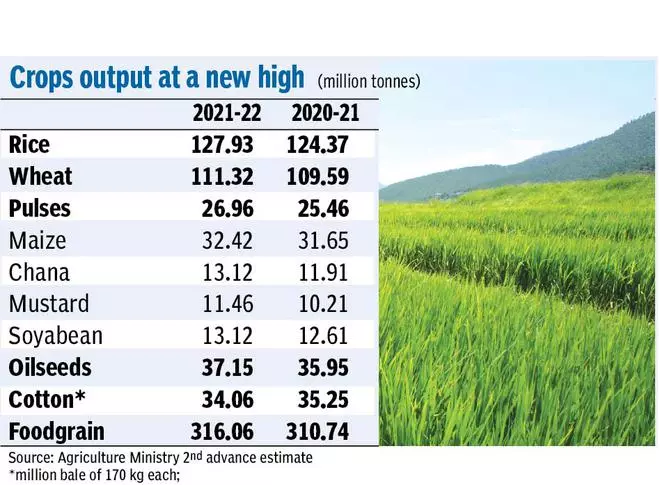India is set to harvest file foodgrains in the 2021-22 crop yr (July-June), many thanks to a new large in the output of rice, wheat, maize and pulses, the federal government explained on Wednesday. The history generation of foodgrains, which has been climbing consistently each and every calendar year due to the fact 2016-17, has assisted India to be amid the top rated 10 agricultural develop exporters in the world. At the similar time, the food items subsidy, as well, has been climbing each year with the surplus acquiring dispersed among the the lousy persons to make certain foodstuff safety.
Whole generation of foodgrains is estimated to be 316.06 million tonnes (mt) this calendar year, comprising 153.54 mt from the kharif period and 162.53 mt from the rabi period, the Agriculture Ministry mentioned releasing the 2nd progress estimates of crops output.

When the progress in the kharif output is approximated at almost 2 for every cent, in the situation of rabi-developed foodgrains, the manufacturing is estimated to expand at 1.5 for each cent. Total, production is up 1.7 per cent from the former 12 months.
“Growth in kharif and rabi output exhibits that there is scope in strengthening output under maize, when a lower in output of rice and wheat may be appealing thinking of the demand from customers and offer predicament in each these commodities,” mentioned NB Singh, an agriculture economist. The harmony has to be preserved as a result of crop setting up by using States into self esteem, he said and cited the the latest example of Telangana where by the Point out governing administration motivated farmers to shift to maize from paddy in the current rabi season.
Crop-smart output
The latest estimates exhibit that wheat creation is likely to be 111.32 mt this year, up by 1.6 for each cent from past year’s 109.59 mt, irrespective of a drop in acreage. Rice production has been pegged at 127.93 mt – 109.54 mt in kharif and 18.39 mt in rabi – and it is up by 2.9 for each cent from last year’s 124.37 mt.
Maize manufacturing is probably to go up by 2.4 per cent to 32.42 mt and that of chana by 10.2 for each cent to 13.12 mt . Over-all, pulses output is set to raise by 5.9 per cent to 26.96 mt from 25.46 mt.
Having said that, there are crops like jowar, bajra, ragi, tur and moong exactly where the generation is believed to drop, although marginally. This is not great for the nutri-cereals sector as the government has been pushing for much more crops beneath this class, Singh mentioned.
Tur manufacturing is pegged at 4 mt, down from 4.32 mt past year even though moong is viewed at 3.06 mt from 3.09 mt. Jowar output is most likely to fall to 4.31 mt from 4.81 mt, bajra to 9.22 from 10.86 mt and ragi to 1.67 mt from 2 mt.
Oilseeds output up
Backed by a strong output in mustard, the overall production of oilseeds is projected at 37.15 mt, up from 35.95 mt past yr. Groundnut generation is probably to be 9.86 mt in opposition to 10.24 mt last yr, soyabean at 13.12 mt versus 12.61 mt final 12 months and mustard at 11.46 mt against 10.21 mt in 2020-21.
Sugarcane output is very likely to be 414.04 mt, up from 405.4 mt past yr, when cotton output has been pegged at 34.06 million bales (each and every 170 kg), down from 35.25 million bales.. Jute output has been estimated to improve to 9.17 million bales (180 kg just about every) from 8.95 million bales, the ministry explained.
Released on
February 16, 2022







